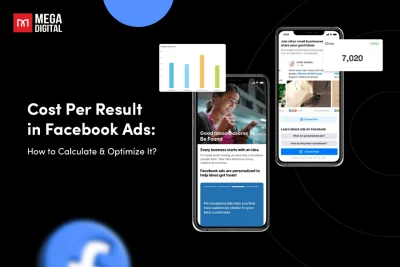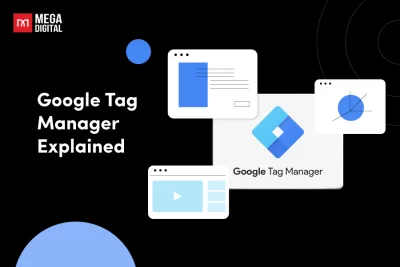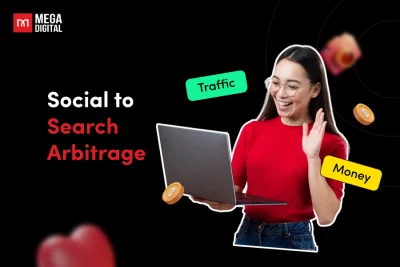Learn about Google Ads Automated Bidding strategies and their hidden secrets. This article is your guide to explore the core benefits of Automated Bidding, the 8 diverse strategies at your disposal, and how to set up and optimize them for optimum campaign performance. Get set on a journey to harness the true potential of your advertising campaigns.
Table of Contents
What is Automated Bidding?
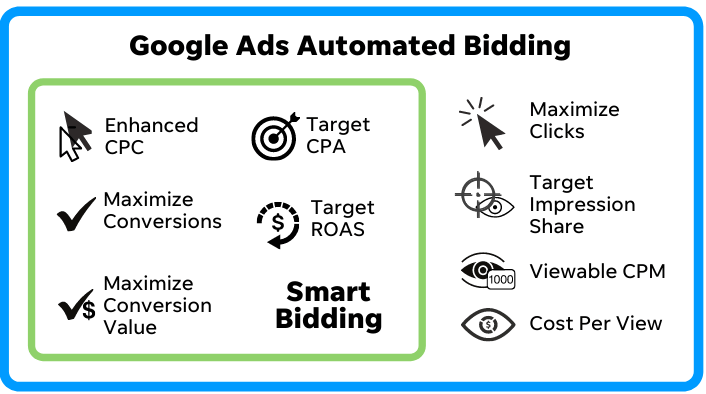
Google Ads Automated Bidding refers to a set of machine learning-driven strategies and tools offered by Google within its advertising platform. These strategies are designed to help advertisers optimize their bidding strategies and maximize the performance of their ads. Automated Bidding uses various data points and signals to adjust bids in real-time for each ad auction, aiming to achieve specific performance goals set by advertisers.
The aim is to optimize the efficiency of your advertising budget by getting the most out of your return on investment (ROI).
To put it in simpler words, it’s like having an intelligent assistant that automatically determines the ideal bidding amount for your ads, all in pursuit of achieving the finest outcomes for you.
Core benefits of Google Ads Automated Bidding
Google Ads Automated Bidding is a useful tool for businesses, big or small. It saves time, boosts conversions, and makes ad spending more effective.
Now, let’s explore the main advantages of using Automated Bidding in Google Ads:
Allow to optimize campaigns based on goals
Automated Bidding within Google Ads permits you to match your campaign goals with specific bidding methods, such as maximizing conversions or reaching a certain target return on ad spend (ROAS). This functionality empowers you to fine-tune your campaigns towards your intended objectives and results.
Guided by your objectives and data analysis, Google’s Automated Bidding system dynamically adjusts bids. It takes into account factors like ad quality, keyword relevance, competition, and user intent to ascertain the most fitting bid for each auction.
As the system accumulates more data and learns from campaign performance, it refines the bidding strategy further. It identifies chances for improvement, spots keywords or placements that aren’t performing well, and tweaks bids accordingly to optimize performance and attain the set goals.
Reduce guessing
Automated Bidding minimizes the risks tied to manual bidding errors. It eradicates missed adjustments, wrong calculations, and human oversights.
With Automated Bidding, advanced algorithms and machine learning drive data-driven bid choices, reducing guesswork and errors. The system adapts based on real-time campaign performance, honing its strategy over time.
This scientific approach curbs uncertainty, making campaigns more effective and goal-oriented.
Boost effectiveness
Automated Bidding simplifies bid adjustments by automatically adapting bids in real time. This eliminates the need for manually monitoring and adjusting bids for individual keywords or ad groups.
Automated Bidding proficiently oversees bids across extensive campaigns or multiple campaigns at once. It obviates manual adjustments and optimizes bids according to each auction’s unique conditions, ensuring effective resource distribution.
By automating bid management, marketers gain the freedom to devote energy and resources to other vital tasks like devising a strategy, refining creatives, and examining campaigns. This enables them to make more influential contributions to overall campaign triumph.
Let’s look at a case study from one of Mega Digital’s customers:
Goibibo, a prominent travel booking platform in Asia, provides hotel and flight reservations through its website and widely used mobile app. In their A/B tests comparing manual bidding to Automated Bidding, they observed a significant 25% surge in hotel transactions. Additionally, hotel non-brand search campaigns recorded a remarkable 22% reduction in the cost per conversion.

Save time
When you automate bidding, you save time that you would otherwise use to change bids by hand. This helps the system improve bids using live data and how well things are going, which means you don’t have to keep watching and changing bids all the time.
You can rely on the automated system to do these jobs well, so you don’t have to spend a lot of time and effort watching and changing bids.
This leaves you free to focus on important choices, like making ads better, trying out new ways to aim at people, or looking at how well the campaign is doing overall.
Enhance budget management
With Automated Bidding, you gain more budget control. You can set limits to keep your search campaigns within budget and optimize bids for top results. This boosts your advertising budget and achieves goals efficiently.
It shows spending patterns, ad performance, and pacing, making sure your budget is well used over time. You can watch your budget use and adjust bid tactics to stay within your budget while getting the best results.
Automated Bidding cuts overspending risk. It tunes bids using performance cues and goals.
By adjusting bids and targeting valuable chances, it lowers wasteful spending. Your budget goes where it matters most, lifting your investment’s value.
Get fast results
Automated Bidding brings swift outcomes by using real-time data and smart algorithms. This means bid tweaks and improvements happen faster than with manual bidding, so you see the effects of bid changes on your campaign’s success sooner.
With Automated Bidding, campaigns can swiftly adjust to market shifts, how people react, and the competitive scene. This leads to faster improvements and better performance.
By tapping into machine learning, Automated Bidding constantly learns from campaign info, spots patterns, and refines bidding strategies for speedy and effective results.
It lets advertisers focus on big decisions, not bid handling. This saves time and boosts business growth speedily.
8 types of Automated Bidding
We will now explore each Automated Bidding strategy extensively and comprehend how they enhance the performance of your ad campaigns.
1. Enhanced cost per click (ECPC)

- Goal: Increase conversions while controlling keyword bids
- Works for: Campaigns, ad groups, keywords
- What it does: ECPC lets Google change your manual bids to bring more conversions while trying to keep the cost per conversion about the same. You can use ECPC if you’re using Manual CPC bidding or as part of a group bid strategy.
- Best time to use: When you’re manually setting bids but still want to use Automated Bidding’s advantages.
2. Maximize clicks
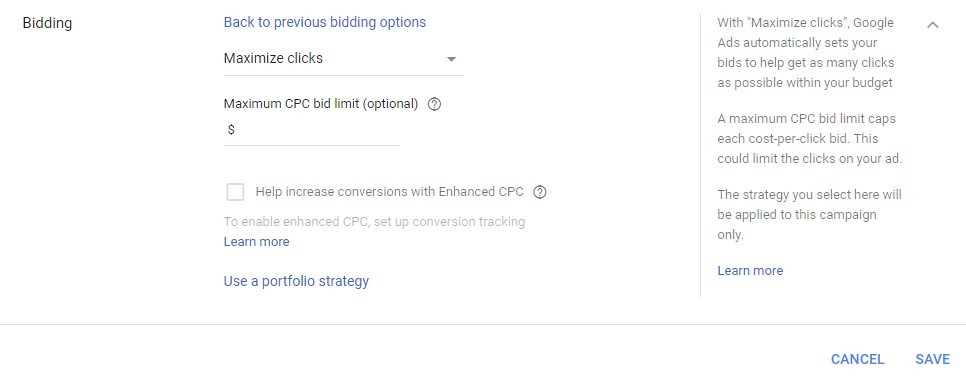
- Goal: Get more people to visit your website
- Works for: One campaign or many campaigns, ad groups, and keywords
- What it does: The Maximize Clicks strategy tries to bring more visitors to your website. It adjusts how much to pay for clicks so you can get as many as possible within the money you’ve set aside. You can use this strategy for just one campaign or for many campaigns, ad groups, and keywords together.
- Best time to use: When you want to lead lots of people to your website and you have a clear path for them to take action.
3. Maximize conversions

- Goal: Get more conversions within your budget
- Works for: Campaigns
- What it does: This strategy adjusts bids to bring you the most conversions for your campaigns, using your entire budget. Google attemps to get as many conversions as possible. Maximize Conversions is available as a regular strategy for separate campaigns, not for a group bid strategy.
- Best time to use: When you have a big budget and want to automate your ads to get more conversions.
4. Target cost per action (tCPA)
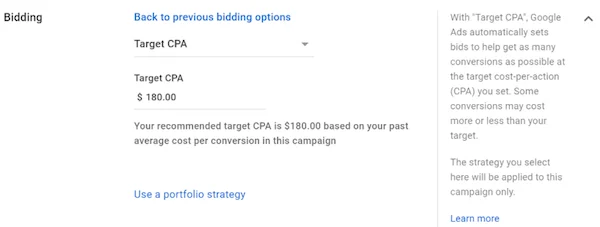
- Goal: Control costs for conversions
- Works for: Campaigns
- What it does: The Target Cost Per Action (tCPA) strategy tailors bids to secure the highest number of conversions while aiming to maintain the cost per conversion close to your chosen target. This strategy uses real-time data and historical performance to adjust bids for each auction.
- Best time to use: tCPA is most effective when you have a clear idea of how much you’re willing to pay for each conversion. It suits campaigns where maintaining a consistent cost per conversion is crucial. If you’re seeking to automate bidding to attain your desired conversion costs, tCPA can be a valuable strategy. Remember that it’s essential to have a sufficient volume of historical conversion data for tCPA to work effectively.
5. Value-based bidding
Within the scope of value-centered bidding, there exist two bidding tactics:
- Maximize conversion value
- Aim for Target ROAS
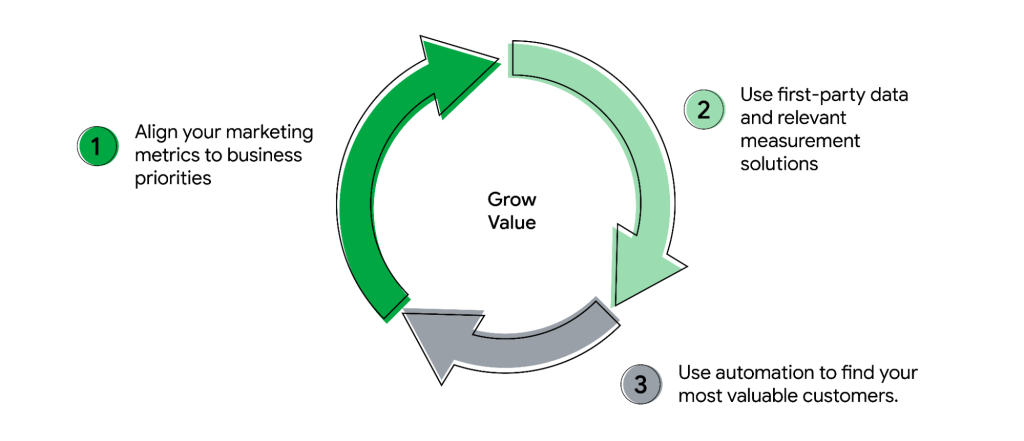
Maximize conversion value

- Goal: Maximize revenue from conversions
- Works for: Campaigns
- What it does: Maximize Conversion Value strategy aims to boost your overall revenue by optimizing bids to generate the highest possible conversion value within your budget. It focuses on driving conversions with higher values, considering factors like conversion rates and value per conversion.
- Best time to use: When your primary objective is to maximize the total value generated from your conversions. This strategy is suitable for e-commerce businesses or campaigns where the value of each conversion varies significantly. By using Maximize Conversion Value, you can prioritize conversions with higher revenue potential and ensure your budget is allocated effectively to generate the most valuable outcomes.
Target return on ad spend (tROAS)
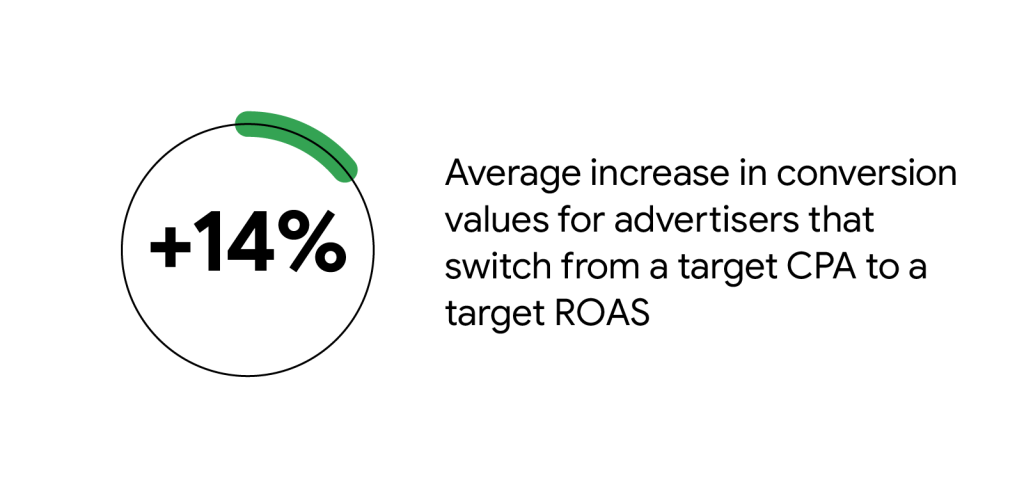
- Goal: Achieve a specific Return on Ad Spend (ROAS)
- Works For: Campaigns
- What it does: Target Return on Ad Spend (tROAS) strategy focuses on maximizing revenue while aiming for a specific ROAS goal. It adjusts bids to ensure that your advertising investment generates the desired level of return in terms of revenue.
- Best time to use: When your primary goal is to generate revenue with a specific return on ad spend in mind. This strategy is particularly effective for businesses with specific profit margin targets or when you want to allocate your budget to campaigns that deliver higher ROAS. By using tROAS, you can optimize bids to attract valuable conversions that align with your desired level of profitability. Remember to have accurate conversion values and historical performance data for this strategy to work effectively.
>>> Read More: Value based bidding: Definition, When to Use and Best Practices
6. Viewable CPM (vCPM)

- Goal: Enhance visibility with viewable impressions
- Works For: Display and Video campaigns
- What it does: Viewable CPM (vCPM) focuses on increasing the visibility of your ads by targeting viewable impressions. It optimizes bids to ensure your ads are displayed in a viewable position on the user’s screen.
- Best time to use: When your main objective is to boost the visibility of your ads and you want to pay for the opportunity to be seen by users. This strategy is suitable for brand awareness campaigns and when you’re more concerned with ad visibility than clicks or conversions. Keep in mind that vCPM works best when you have visually engaging creatives that captivate your audience’s attention.
7. Cost per view (CPV)
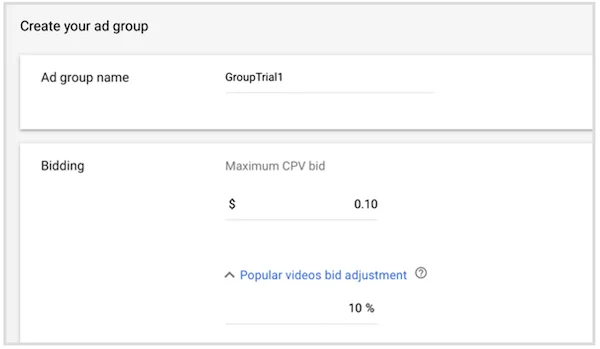
- Goal: Optimize for video views
- Works for: Video campaigns
- What it does: Cost per view (CPV) strategy is designed to maximize video views within your allocated budget. It adjusts bids to ensure your videos are seen by your target audience, with the cost charged only when someone views a significant portion of your video.
- Best time to use: When your primary objective is to drive engagement through video content and you’re willing to pay for each view. CPV is suitable for campaigns where video views are a key performance metric. It’s especially effective for building brand awareness and connecting with your audience through captivating video content. Note that for CPV bidding, compelling and engaging video content is essential to capture and retain viewers’ attention.
8. Target impression share
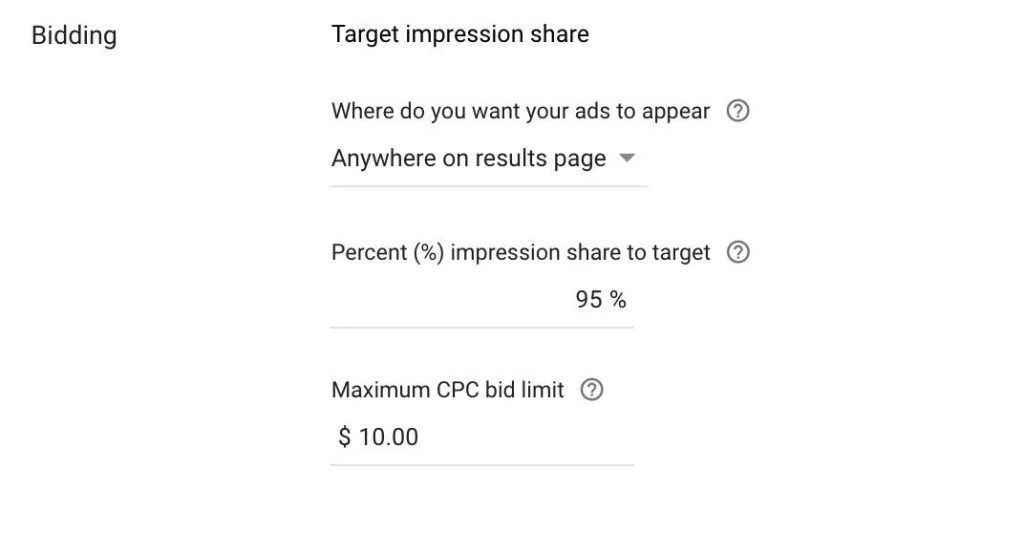
- Goal: Maximize ad visibility on Google Search
- Works for: Search campaigns
- What it does: Target Impression Share strategy aims to increase the visibility of your ads on Google Search by targeting a specific impression share percentage. It adjusts bids to help your ads appear in a certain percentage of eligible ad auctions.
- Best time to use: When your main goal is to ensure your ads are visible to users in a certain proportion of relevant searches. This strategy is ideal for brand campaigns or when maintaining a strong online presence is essential. It’s especially valuable when you want to outshine your competitors and dominate search results. Keep in mind that using Target Impression Share may require higher bids to achieve your desired impression share, so it’s important to consider your budget and goals carefully.
For those new to Google Ads, Automated Bidding may appear simpler, but it still requires campaign setup, management, and monitoring. Google Ads agencies like Mega Digital provide expertise in tracking metrics and strategic insights beyond Automated Bidding’s scope.
How to set up Automated Bidding
Requirements:
To use Automated Bidding, you must have conversion tracking enabled (unless you are using Enhanced CPC with Display campaigns). Additionally, Google recommends that advertisers have at least 30 conversions in the past 30 days before using Target CPA and at least 50 conversions before using Target ROAS.
To establish an Automated Bidding plan:
- Log in to your Google Ads account.
- Select Tools and Settings from the top menu.
- Click on Shared Library.
- Choose Bid Strategies.
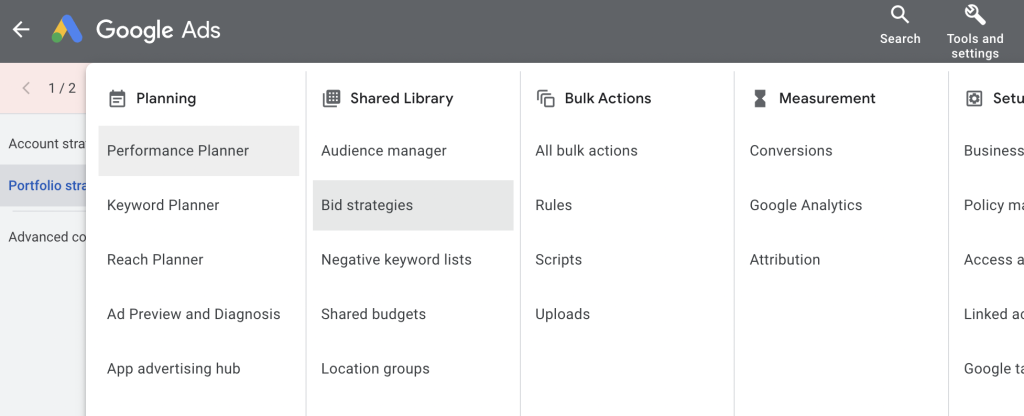
Starting here:
- Click “Create new bid strategy.”
- Choose the Automated Bidding strategy you prefer.
- Input your bidding strategy’s settings.
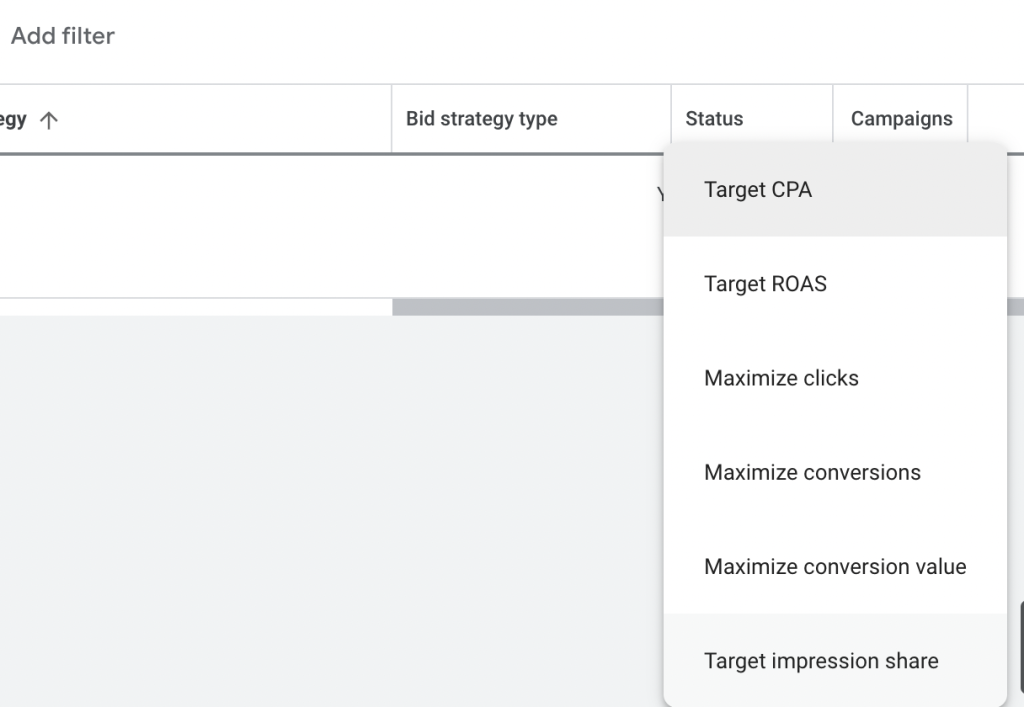
Click on Create. Now you’re done!
How to choose the right bidding strategy
Know your goals
The first step in selecting an Automated Bidding strategy is understanding your campaign’s goals. Do you want to increase website visits, generate sales, or boost brand awareness? Your goal will shape your bidding strategy. For instance, if your focus is on driving sales, you might consider a strategy that optimizes for Return on Ad Spend (ROAS), while aiming for more clicks could lead you towards a Maximize Clicks strategy.
Check past performance
Take a look at your campaign’s historical performance. Review metrics like conversion rates, click-through rates, and cost per conversion. Identify which strategies worked well in the past. This analysis can provide valuable insights into the bidding approaches that resonate with your audience and yield positive results.
Measure conversions properly
Accurate data is crucial for Automated Bidding. Ensure to set up your conversion tracking correctly. If your goal is to track purchases, ensure that every sale is being counted accurately. Proper tracking ensures that the bidding system has reliable information to make smart decisions.
Understand competition
Consider the competitiveness of your industry. If you’re operating in a highly competitive space, it might be more challenging to stand out. In such cases, you might opt for bidding strategies that are more aggressive in order to win valuable ad placements and clicks.
Test and learn
Experimentation is key. Allocate a portion of your budget to test different bidding strategies. Run parallel campaigns using different strategies and compare their performance. Monitor metrics such as cost, conversions, and revenue. Over time, you’ll gather insights into which strategy aligns best with your goals and audience.
Remember that selecting the right bidding strategy is an ongoing process. Campaigns can evolve, and market conditions change. Regularly review your campaign’s performance, adjust your strategy as needed, and stay updated on the latest developments in Google Ads Automated Bidding options.
>>> Read more: Smart Bidding in Google Ads: All 4 Strategies and How to Choose
Best practices of Google Ads Automated Bidding
Set clear campaign goals
Automated Bidding strategies are most effective when they are aligned with specific campaign objectives. Before implementing Automated Bidding, define your goals clearly. Are you aiming to maximize conversions, achieve a target ROAS (Return on Ad Spend), or increase website traffic? Knowing your primary goal is essential, as each Automated Bidding strategy is designed to optimize for different outcomes. Without a clear objective, it’s challenging for the system to make informed bidding decisions.
Check conversion tracking
Accurate conversion tracking is the lifeblood of successful Automated Bidding. Define what actions on your website constitute valuable conversions, whether it’s a purchase, a lead form submission, or another desired outcome. This data enables Google Ads to understand which clicks lead to meaningful interactions. Without proper tracking, the Automated Bidding algorithms lack the information needed to make effective bid adjustments.
Monitor and adjustments regularly
While Automated Bidding can streamline bid management, it doesn’t mean a “set it and forget it” approach is sufficient. Automated strategies require time to learn and adapt to changes in the advertising landscape. Regularly monitor your campaign’s performance and be prepared to make adjustments as needed. This includes assessing whether your Automated Bidding strategy is achieving your desired results and tweaking settings accordingly.
For example, if you notice that your campaigns are consistently underperforming in terms of conversions or ROAS, consider adjusting your target values or experimenting with different Automated Bidding strategies.
Final words
In the dynamic world of online advertising, Google Ads Automated Bidding is your ally in the quest for efficiency, precision, and results. Embrace the power of automation to streamline your bidding, optimize your campaigns, and achieve your advertising goals with greater ease. Stay up to date, adapt as needed, and let automation pave the way for a brighter and more successful advertising future.
>>> Read more: Best Google Ads Bidding Strategies and Pro Tips in 2023





